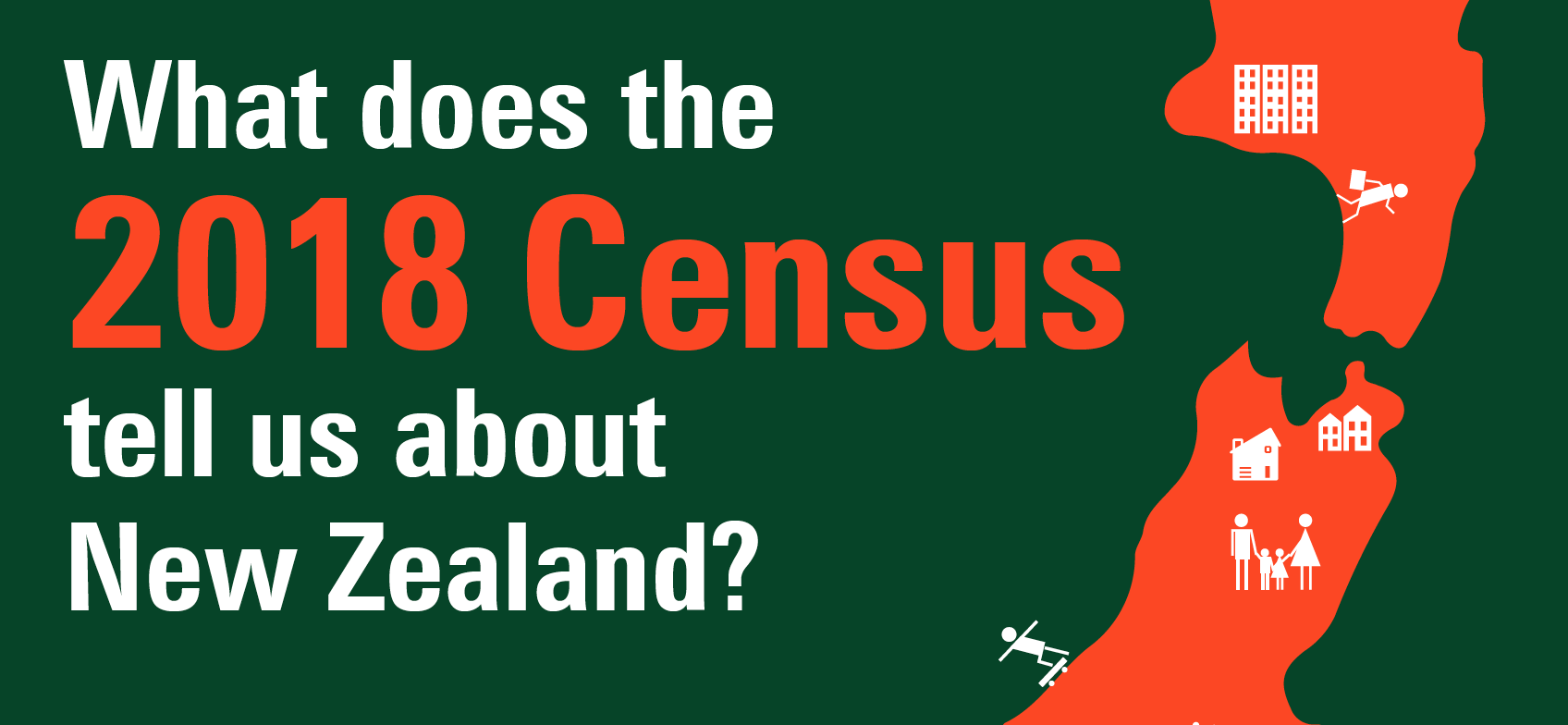Today, Stats NZ has released the first round of data from the 2018 Census. In this piece, we share some highlights from the first release and explain how we’ll be updating our Community Profiles as data continues to be released from Stats NZ.
In light of the challenges with the 2018 Census, we know many of you are wondering if you can use this data with confidence. If you haven’t already, download a free copy of our handbook, ‘Worth the wait: a guide to navigating the 2018 New Zealand Census.” This simple guide was written as a reference guide to complement the information in our community profiles, and help New Zealanders, particularly our partners in Local Government, understand how changes in the 2018 Census affects data for their area.
In this update
The first data from the 2018 Census is now available
Statistics New Zealand has just released the first results from their 2018 Census collection. There are a lot of caveats around datasets which are partly admin records and partly Census counts, but most of the datasets are good to use and are expected to be released progressively over the next few months. We will be taking this all into account as we update data on our Community Profiles, ensuring you can be confident in the evidence base presented.
There are only minimal datasets in this initial release – mostly single variables at a national level available, as well as total population and dwelling counts for each Territorial Authority and Regional Authority.
Highlights from the first release
The New Zealand 2018 Census count was 4,699,089 people usually resident, representing an increase of 10.8% from 2013 – more than double the 5.3% growth from the previous Census period (which was actually longer, at 7 years, due to the Christchurch earthquake in 2011).
So, this is a 2.1% annual growth rate – substantially higher than Australia’s current population growth, which has been around 1.7% p.a. over the same time period.
The 10 Territorial Authorities with the most growth 2013-2018
Here are the top 10 increasing areas by Census count in 2018.
The local figures aren’t out yet, but the main driver of this growth seems to be strong international migration. New Zealand’s population born overseas has risen from 23.6% in 2013, to 27.0% in 2018.
Where is the Growth in New Zealand?
While Auckland continues to make up the lion’s share of the growth, adding 156,168 people, over a third of the nation’s growth – most areas are growing.
In fact, of the 67 Territorial Authorities in New Zealand, 65 of them showed growth between 2013 and 2018.
Growth in the South Island
The fastest growth in percentage terms was Queenstown-Lakes District, up 38.7%, or almost 11,000 people, followed by Selwyn District (+35.8%) on the outskirts of Christchurch. Christchurch itself added 8%, or 27,537 people, after declining in the previous Census period due to the earthquake.
Growth in the North Island
However, the weightiest changes are occurring in the North Island, with growth around the Auckland juggernaut – in Northland, Bay of Plenty and Waikato – pushing population numbers up so now half New Zealand’s population live north in the four northern-most regions. One and a half million people reside in Auckland.
Despite the being over 100,000 more people in the South Island than there were five years ago, the North Island is still home to three-quarters of New Zealand’s population. Stats NZ expects that the country will reach 5 million people in 2020.
Growth is not the story everywhere
While growth was the story in most areas, it has not been ubiquitous across all TAs in New Zealand. The only two areas of population decline are Buller District and Grey District, both on the West coast of the South Island. Buller lost 882 people in 5 years, while Grey was just marginally down by 27 people (effectively stable).
How will this data be added to our Community Profiles?
Many councils in New Zealand subscribe to our Community Profiles and Social Atlases. In their initial release, Stats NZ have provided a snapshot of population growth over the past 5–10 years.
We are working closely with Stats NZ to ensure we can start updating data on our community profiles and social atlases as soon as possible. We will be adding data to our New Zealand Community Profile sites progressively as smaller area datasets become available from Stats New Zealand.
Much of the data on our Community Profiles require a custom data order. We have lodged a data order with Stats NZ and understand they will begin to fill these orders from late September. To help this data-order process, we have provided Stats NZ with a priority ordered list for topic groups.
- “What is the population” and “How do we live?” topics
- “Who are we” topics
- “What do we do?” topics
- “Specialist profiles” Census-related topics
- New Census topics we are planning to add to the site.
Note that this is not necessarily the order data will be updated on the site; that depends on the order in which data is supplied by Stats NZ.
In the meantime, we continue to support our clients through the upcoming geography changes.
How to keep up-to-date with releases
The best way to be notified of data updates on our sites is to subscribe to our product updates. We will send you an email when new data is released and updated on our Community Profile and Social Atlas sites.
Is the data 2018 Census data reliable?
As we said at the beginning of this post, we believe the data from the 2018 Census. Stats NZ have undertaken rigorous quality assurance processes – in fact, much of the delay in releasing the data has been to ensure the data that is released is a robust evidence base for decision making.
Stats NZ has also released the first of two reports tabled by the External Data Quality Panel. The Panel is an independent body co-chaired by Emeritus Professor Richard Bedford. You can read the full report from that panel here.
.id will ensure the Census data we present our sites can be used with confidence in understanding the demographic story of a place and making informed decisions.
Where can you learn more about the Census 2018?
- Visit the StatsNZ site for all the latest on their work with the 2018 Census.
- Download a free copy of our Census handbook – Worth the wait: a simple guide to navigating the 2018 Census. Click here for your free copy.
- If you work in local government in New Zealand, you can contact Penny Bloomberg for assistance regarding the insights available from the 2018 Census. Contact Penny via our contact us page, or email info@id.com.au









